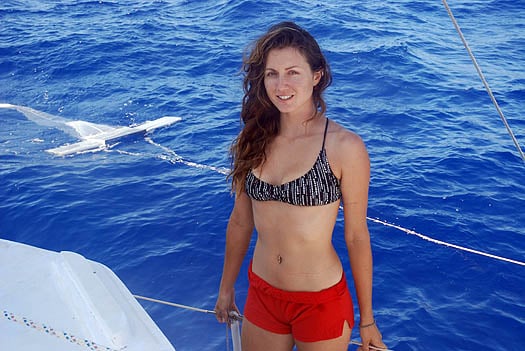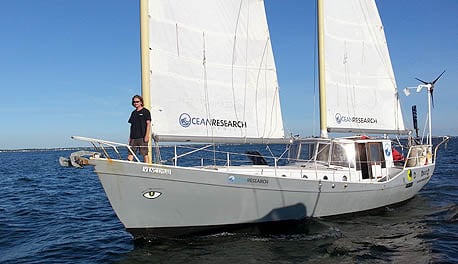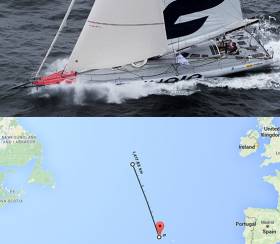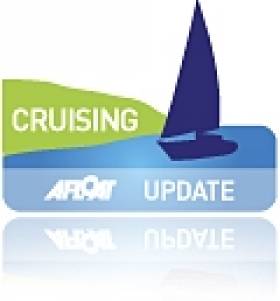Displaying items by tag: abandoned yacht
Abandoned IMOCA 60 Yacht. It's Red & White & 60ft Long. Ireland Please Keep A Look Out!
British sailor Richard Tolkien (61), one of the competitors in the race from Plymouth to New York, abandoned his yacht '44' and boarded the Cargo Ship ANTON TOPIC on Friday. Tolkein, who sustained head injuries in the abandonment, say it is his intention to recover the boat that is currently believed to be in a location nearly nine hundred miles north west of the Azores.
“I had to leave the boat which has a tracker on it – not an easy situation - and I hope to rescue the boat he said after the ordeal.
Locating the boat will not be easy according to Kinsale based Marcus Hutchinson who co-ordinated and recovered another abandoned IMOCA yacht last January. Hutchinson and a team set out from West Cork and rescued the SMA sponsored IMOCA Yacht last January.
Hutchinson told Afloat.ie he wasn't sure if the boat would make it into Irish waters: 'it is a lot further south and west and the weather is a bit different at this time of year so would take a lot longer. Also, I think the tracker, which is yellow brick, won't last for more than a couple of weeks', he said.
The movement of the yacht depends on the rig set up and what sails are still flying. It is unlikely to reach Ireland on the basis of current alone as it’s too far south and as it moves east there is a southerly element to the ocean current so it will probably end up moving south on the Canary current.
However, like SMA, the sail set up could promote sailing and more than counteract current if there is a south westerly and if it is more wind influenced it could “sail” in a north easterly direction – if it did this at 5 knots, it would be 300 hours or around two weeks before it got to the Irish coast.
Risk Outweighs Reward to Salvage Abandoned Yacht as Wolfhound Found Again
#wolfhound – On board the research vessel AULT, a specially outfitted vintage Tom Colvin-designed 42-ft. steel-hulled sailboat transformed into a scientific mobile observation platform, was celebrated solo circumnavigation of the Americas in 2012 record holder Matt Rutherford and marine environmental scientist Nicole Trenholm. It was day 47, July 22nd, 2013, at sea in the North Atlantic Sargasso Sea Gyre conducting data collection with a manta net of marine debris, a 3-month journey by Matt's Annapolis-based non-profit Ocean Research Project, and reporting atmospheric and oceanic observations as a Voluntary Observing Ship for marine agencies. (See at www.oceanresearchproject.org )
After a very long day, suddenly they noticed a sailboat with no sails that seemed to be drifting. Thinking someone aboard may need assistance, Matt and Nicole changed course to investigate. As they passed close to the vessel no one answered Matt's hailing. He jumped into a flimsy kayak they had brought and paddled over to the boat he discovered empty. Boarding he found the owner's name (Alan McGettigan) and his insurer, he called both about the abandoned 48-ft. Nautor Swan named Wolfhound previously reported sunk in a severe storm after the owner and crew of three rescued and brought to the Irish coast. She did not sink however and reappeared some 800 miles southeast of Bermuda until spotted once again.
Nicole Trenholm, who was first to spot the abandoned vessel on the horizon, later said that the resulting encounter would prove to challenge their strength both physically and mentally and inevitably handicap their ability to promptly make landfall for repairs. The following is an excerpt in Matt's own words from a posting at sea of their attempt to 'capture' the Wolfhound.
WOLFHOUND
Excerpt from Ocean Research Project to AFLOAT.ie with permission
The next day I returned to Wolfhound and pumped all the water out of the bilge. I had to secure the mast because the forestay and backstay were broke. I secured the mast with a few halyards, the mast wouldn't be able to support a sail but at least the mast wasn't going to fall down. She was dragging an anchor which I pulled back on board and tied off. I also took down the ripped up main sail and stowed it away inside the cabin. I had done everything I could to secure the Swan.

Marine environmental scientist Nicole Trenholm, who was first to spot the abandoned vessel on the horizon
Nikki and I discussed our game plan. We didn't have enough fuel to tow Wolfhound all the way to Bermuda so the next day I was going to kayak back to the Swan and pump out its fuel tank hoping to get at least 30 gallons of diesel. The next day I disconnected one of my ships batteries placed in the kayak and paddled back to the Swan. I used a waste pump that I found which was brand new still in its box and my big group 31 battery that I brought and started to pump Wolfhounds fuel tank dry. I was disappointed when I only got 12 gallons of diesel. I tried to bring back a jerry can with the Kayak but the Kayak flipped, I was being drug behind the Swan with one hand on the kayak and the other hand on the swim ladder. I dragged myself and the kayak back onboard and decided there was no way to get my battery and three jerry jugs back to my boat using the little kayak. After searching around I found a Zodiac inflatable on Wolfhound so I pumped it up and threw it overboard. At least now I have a good way to shuttle the 12 gallons of diesel and my big battery back to my boat. Then craziest thing happened. On the way back to my boat the bottom fell out of the dingy. One minute I'm just rowing along and the next minute I'm looking down at nothing but water. My 100 pound battery I brought with me had a line attached to it and the line nearly rapped around my leg. If it had it would have taken me to the bottom of the ocean with it. I struggled to get back to my boat and climbed aboard, but I did manage to save the 3 jerry cans that had the 12 gallons of fuel in them. Nikki and I set aside 20 gallons of fuel in reserve and decided if we can't get Wolfhound to Bermuda with the remaining fuel then we cut her loose and use the 20 gallons of reserve fuel to get to Bermuda without her.
The next day we spotted a freighter and asked the freighter if it could spare 50 gallons of diesel. At first they were hesitant but when the saw that we were towing a sailboat the freighter agreed to help. I had to pull up next to a slow moving freighter, stay 10 feet from its hull and maintain a prefect course in order to get the fuel. It took every bit of skill I had to hold my boat in that position for an hour as the guys on the freighter lowered one jerry jug at a time down to Nikki. It was absolutely nerve racking. You never want to be that close to a freighter in the open ocean, but if we could pull it off we would have enough fuel to easy tow the boat to Bermuda.
As we pulled away from the freighter we were all smiles. We now had enough fuel to motor to Bermuda. We were going to pull it off. A few hours later I noticed our RPM gauge was jumping around and the engine was starting to struggle. I backed down the throttle and the engine died immediately. I said to Nikki 'we must have got dirty diesel, I'll change the fuel filter'. I changed both fuel filters and bled the air out of the engine and she still wouldn't start. It was getting dark so I thought it best to get some rest and deal with it tomorrow. The next day I took my oil extraction pump and jury rigged it to my primary fuel filter. This way I could pump all the dirty fuel out of the fuel tank through the fuel filter and into jerry jugs. By doing this I would clean all the fuel and then I could pour it back in the tank. I had to sacrifice two more fuel filters but it went remarkably well and now all the fuel was clean. I only had one fuel filter left but we should be okay. I reconnected the primary fuel filter to the engine, we bled out the air and — nothing. The engine still wouldn't start. I spent the next 36 hours bleeding and re-bleeding my engine until I had to finally except that the fuel I got from the freighter was so bad that it ruined my fuel injection pump. There is no way to fix that out at sea, my engine was dead.

Matt Rutherford on the bow of the research vessel AULT, a specially outfitted vintage Tom Colvin-designed 42-ft. steel-hulled sailboat
That changed everything. Now the only hope we had to get Wolfhound to Bermuda was to get her engine started. The first thing I had to do was remove the lines that had rapped themselves around Wolfhounds propeller. It took about an hour of hard swimming before I could get all the lines off of Wolfhounds prop. While I was doing that a line rapped around the propeller on my boat. I had to cut lines off of two different boats propellers back to back in the middle of the open ocean. By the end I was covered in scraps and cuts and completely exhausted. After that fiasco I took another one of my ships batteries over to the Swan 48 and got it connected to the ships electric system. I was able get the engine to turn over but I couldn't get it to start. At this point the wind died and my boat stopped but the Swan didn't. I watch helplessly as the Swan rammed my boat putting a dent in the side of my ship. Then it spun around and the tow line rapped around it rudder, so now we were pulling it backwards. It took three hours to finally get the Swan 48 spun back around the right way. As all of this was happening the seas were building. I was still on Wolfhound and Nikki was on Ault. There was no way I would be able to bring my battery back to my boat and from the looks of it I would be lucky to get back at all. I narrowly managed to row the little kayak back to my boat as each wave was trying to flip me.
Again Nikki and I sat down to discuss a new game plan. Between the two boats we had two broken engines and only my boat could sail. We got an accurate weather report from Predict Wind that told us for the next 7 days we had nothing but headwinds and light winds. We tried to tow her under sail into the wind but the combined leeway was pushing us east, further out to sea and away from Bermuda. We knew if we dragged the boat long enough we could get to Bermuda but how long, two weeks, a month? Every day that went by my boat was receiving more damage. That and it is hurricane season, we can't just be out here like a sitting duck. Just as Nikki and I were having this conversation I heard a noise. The towline had rapped itself around my windvane again threatening to rip it off. We are out here to do research not salvage boats. You cannot let greed corrupt good judgment. There comes a point when the risks outweigh the reward. At 4:30pm after 5 long days of towing Wolfhound I cut the line.
We cut Wolfhound free and started making some headway when the halyard on the mainsail failed and for the last 36 hours we have been trying to beat into 15-20 knot headwinds with only a foresail, going nowhere. In a day or two when the wind dies I will climb my unstayed mast to the top and fix the problem. I can't say I want to do it, but it has to be done. After that difficult climb up the mast we will be able to raise our main sail again but then we will be becalmed for 3-5 days. When the wind finally picks back up we will continue back to land.
On the bright side of things, every major sailing trip I've ever done I did with a broken engine so it's nothing new to me. There are no big storms anywhere in the Atlantic (for now) and we have plenty of food and water. We won't be going anywhere for the next 5 days because of the light winds but at least we will have a chance to clean the boat up, fix things and regroup.
Matt Rutherford
Longtime U.S. marine law writer, Joan Wenner, J.D., advises Matt and Nicole arrived safely at their Annapolis homeport in early September after a delay for engine repairs in Bermuda (where they made front page news) and are preparing for a 2014 Artic scientific expedition. Read about them at Ocean Research Project's website and click on About Us. Additional sponsors gratefully sought.






























































